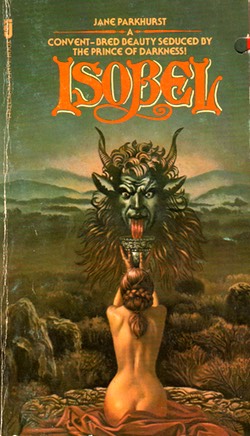Welcome to Freaky Fridays, your Dark Lord and Master who rises from the infernal pit and commands you to seek dusty out-of-print paperbacks from used bookstores and read them until your face melts off and slides down your chest.
Satan sure is a popular fellow! People are constantly praising him, praying to him, worrying about him, gossiping about him, cursing him, and sacrificing virgins to him. God’s pretty powerful, but Satan’s got cults, horror movies, the Smurfs, most children’s toys, and heavy metal music in his corner.
But how does Satan work? Where does he go? What does he do? Can he be washed with water or do you need a fast-evaporating alcohol-based spray to get the grime out from between his wings? All the following books have something to say about Satan and so I’m going to run through them quickly to make sure you get as much useful info as possible in the smallest amount of space. It’s the Freaky Friday way!
The Devil Finds Work (1976)
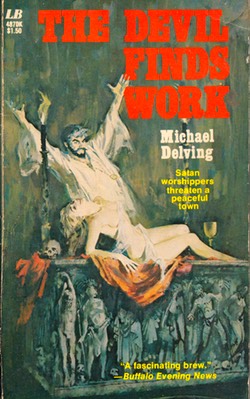 Actually, there’s no work for the Devil at all in the tiny British village of Altoncester, and that’s the problem. Driven mad by boredom, wealthy person Anthony Gaunt stages a couple of thefts then commits a few murders to cover them up. Unraveling his crimes are Delving’s regular crime-solving duo, the antique dealers Dave Cannon and Bob Eddison (Bob’s a Cherokee, by the way), who appear together in seven other books. At no point does a woman with a heaving bosom share a sacrificial altar with a skull, although there is an archery contest. In an attempt to capitalize on Satan’s popularity, Delving gave his murderous squire a tenant, Tristram Vail, an Aleister Crowley clone who’s entered his dotage and is living on his former acolyte’s property. Vail attempts to sell the antique-dealing duo his library of manuscripts bound in human skin, and he’s also peddling a tell-all memoir about his black magic gangbangs (known as “The Communion of the Five Receptacles”). Michael Delving was a pen name for Jay Williams, a Borscht Belt comic who earned a Purple Heart in World War II before becoming a full time author and Anglophile who kept homes on both sides of the Atlantic while writing something like 79 books. He died at the age of 64 while running for a bus.
Actually, there’s no work for the Devil at all in the tiny British village of Altoncester, and that’s the problem. Driven mad by boredom, wealthy person Anthony Gaunt stages a couple of thefts then commits a few murders to cover them up. Unraveling his crimes are Delving’s regular crime-solving duo, the antique dealers Dave Cannon and Bob Eddison (Bob’s a Cherokee, by the way), who appear together in seven other books. At no point does a woman with a heaving bosom share a sacrificial altar with a skull, although there is an archery contest. In an attempt to capitalize on Satan’s popularity, Delving gave his murderous squire a tenant, Tristram Vail, an Aleister Crowley clone who’s entered his dotage and is living on his former acolyte’s property. Vail attempts to sell the antique-dealing duo his library of manuscripts bound in human skin, and he’s also peddling a tell-all memoir about his black magic gangbangs (known as “The Communion of the Five Receptacles”). Michael Delving was a pen name for Jay Williams, a Borscht Belt comic who earned a Purple Heart in World War II before becoming a full time author and Anglophile who kept homes on both sides of the Atlantic while writing something like 79 books. He died at the age of 64 while running for a bus.
Black Easter (1969)
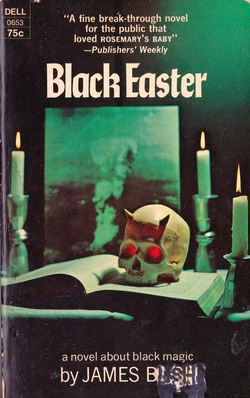 Satan sold in 1969, but this was not yet the muscular Satan of The Exorcist who broke up homes and made young girls cry. This was the cult n’coven Satan of Aleister Crowley and Anton LaVey, which had, at its heart, that most Swinging of Sixties social activities, the Black Mass. Full of music, chanting, hip black robes with crazy cowls, silver jewelry (ankhs, pentagrams, the head of Baphomet), incense, drugs, blood swilled from a groovy chalice, and naked women draped across the altar, the Black Mass is basically Satanism’s square dance. The imagery was so happening and now that it appeared everywhere, even on this cover of a James Blish fantasy novel that had absolutely zero to do with Satan.
Satan sold in 1969, but this was not yet the muscular Satan of The Exorcist who broke up homes and made young girls cry. This was the cult n’coven Satan of Aleister Crowley and Anton LaVey, which had, at its heart, that most Swinging of Sixties social activities, the Black Mass. Full of music, chanting, hip black robes with crazy cowls, silver jewelry (ankhs, pentagrams, the head of Baphomet), incense, drugs, blood swilled from a groovy chalice, and naked women draped across the altar, the Black Mass is basically Satanism’s square dance. The imagery was so happening and now that it appeared everywhere, even on this cover of a James Blish fantasy novel that had absolutely zero to do with Satan.
The Wild White Witch (1973)
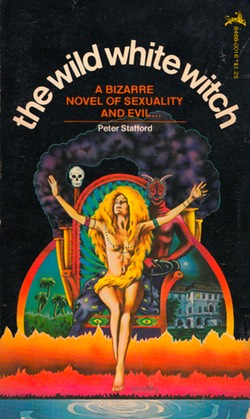 Paul Tabori was a Hungarian journalist and psychical researcher who wrote novels under a number of pen names (like Peter Stafford) when he wasn’t hosting dinners for The London Ghost Club. Ron Walotsky’s cover for this book trembles on the brink of a full-blown psychedelic freak-out, but instead of the promised swinging Satanic hijinx, we get a pulpy fever dream in which young Jeremy Radlett is sent from Scotland to Jamaica in 1830 to work for his estranged uncle on his sugar plantation, Rosehall. He arrives to find that his uncle is dead, his uncle’s sexy young wife, Melissa, is in charge, and before you can say “Haggis” she’s using sex to enslave him to her will. Known as The White Witch of Rosehall, Melissa keeps all her slaves under control with a whip and an enormous dildo when she’s not drinking their blood in kinky underground rituals. There’s only one way this can end: Melissa is torn to shreds during a massive slave uprising, leaving Jeremy older, but wiser, and no longer interested in sugar cane cultivation.
Paul Tabori was a Hungarian journalist and psychical researcher who wrote novels under a number of pen names (like Peter Stafford) when he wasn’t hosting dinners for The London Ghost Club. Ron Walotsky’s cover for this book trembles on the brink of a full-blown psychedelic freak-out, but instead of the promised swinging Satanic hijinx, we get a pulpy fever dream in which young Jeremy Radlett is sent from Scotland to Jamaica in 1830 to work for his estranged uncle on his sugar plantation, Rosehall. He arrives to find that his uncle is dead, his uncle’s sexy young wife, Melissa, is in charge, and before you can say “Haggis” she’s using sex to enslave him to her will. Known as The White Witch of Rosehall, Melissa keeps all her slaves under control with a whip and an enormous dildo when she’s not drinking their blood in kinky underground rituals. There’s only one way this can end: Melissa is torn to shreds during a massive slave uprising, leaving Jeremy older, but wiser, and no longer interested in sugar cane cultivation.
The Devil’s Bride (1932/1976)
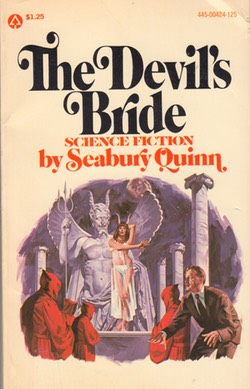 Between 1925 and 1951, Seabury Quinn wrote 93 supernatural mysteries for pulp magazine Weird Tales, featuring his tiny, dapper French investigator of the unknown, Jules de Grandin. Written in 1932, The Devil’s Bride was the only full-length Jules de Grandin novel, and it was published in paperback by Popular Library in this 1976 edition with a cover by prolific, award-winning science fiction painter, Vincent di Fate. A wild brunette in her underpants doing the frug on a Satanic altar while sporting a pair of horns gives only a hint at the chaste decadence on display inside. The only publication Seabury Quinn wrote for as prolifically as Weird Tales was Casket & Sunnyside, a funeral home trade journal he edited in his day job as an expert on mortuary law.
Between 1925 and 1951, Seabury Quinn wrote 93 supernatural mysteries for pulp magazine Weird Tales, featuring his tiny, dapper French investigator of the unknown, Jules de Grandin. Written in 1932, The Devil’s Bride was the only full-length Jules de Grandin novel, and it was published in paperback by Popular Library in this 1976 edition with a cover by prolific, award-winning science fiction painter, Vincent di Fate. A wild brunette in her underpants doing the frug on a Satanic altar while sporting a pair of horns gives only a hint at the chaste decadence on display inside. The only publication Seabury Quinn wrote for as prolifically as Weird Tales was Casket & Sunnyside, a funeral home trade journal he edited in his day job as an expert on mortuary law.
Isobel (1977)
Och! What’s a firey-haired young Scots lassie to do when she’s forced into marriage with a man she canna stand? Well, if it’s 1630 and you’re Isobel Gowdie, the only witch who ever freely confessed to her crimes, you don’t have to milk cows then lie in your straw bed thinking of England while your hateful husband churns up some babies inside your belly. You can be a witch and go dance around at sabbats and have sex with the Devil. Wheeeee! Based on the real-life story of Isobel Gowdie, in Jane Parkhurst’s historical novel, herb-gathering leads to learning ESP, which leads to the ability to control dreams, which leads to the power to heal and command animals, which leads to Devil sex. Isobel loves scrumping Satan because he is actually her tall, dark French lover, Etienne de Beauvoisin, in disguise, but then she finds out that he’s also quite literally the son of Satan. The good times come to a screeching halt when Gowdie confesses and is, we assume, executed. That electrifying art is the first cover painting by Rowena Morrill, one of the all-time greats, and one of the only artists who can brag that her work has not only graced the cover of the all-time greatest Metallica bootleg album, but also hung in one of Saddam Hussein’s love nests.
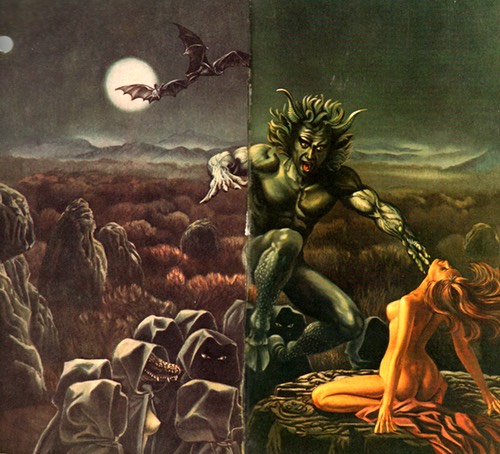
So what have we learned about Satan from these five books? Absolutely nothing, except for the fact that he’s so popular you need him on the cover of your book even if you never mention him at all.
 Grady Hendrix has written for publications ranging from Playboy to World Literature Today; his previous novel was Horrorstör, about a haunted IKEA, and his latest novel, My Best Friend’s Exorcism, is basically Beaches meets The Exorcist.
Grady Hendrix has written for publications ranging from Playboy to World Literature Today; his previous novel was Horrorstör, about a haunted IKEA, and his latest novel, My Best Friend’s Exorcism, is basically Beaches meets The Exorcist.










